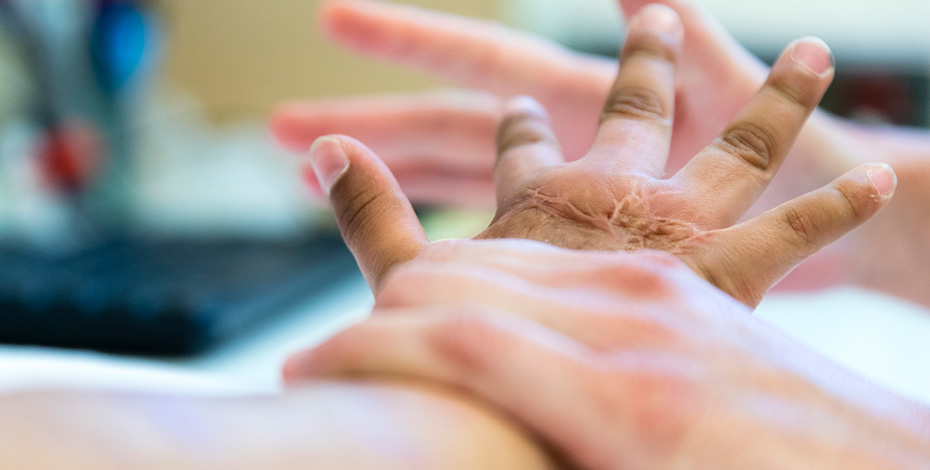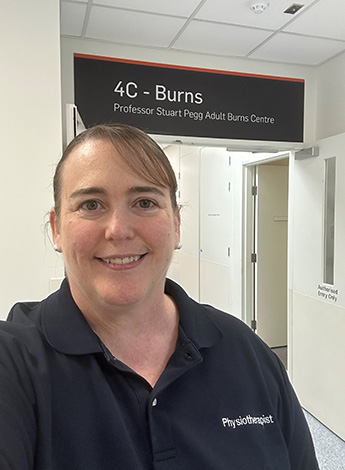
Delivering burns rehab by telehealth

Burns researcher and physiotherapist Anita Plaza talks about a recent study comparing telehealth with in-person rehabilitation services for patients with burn injuries.
Physiotherapist-directed exercise is a key component of burns rehabilitation, helping to reduce scar contracture and improve range of motion, muscle strength, exercise capacity and quality of life.
‘Our main role as physiotherapists is to try to improve movement in general.
‘That includes increasing patients’ ability to stretch, move, build their strength and get back to work as well as looking at the scar process to make sure that we’re using techniques that are going to improve scar quality and appearance,’ says Anita Plaza APAM, physiotherapy consultant and team leader at the Professor Stuart Pegg Adult Burns Centre at the Royal Brisbane and Women’s Hospital.
‘Right from day one it’s about trying to maximise the patient’s ability to function.’
Anita recently published a paper in the journal Burns comparing telehealth-delivered physiotherapy exercise programs to in-person programs for patients with burn injuries.
The study was funded by a Physiotherapy Research Foundation Seeding Grant, awarded in 2020.
Driving the research was the disparity in access to services for patients living outside metropolitan areas.
‘We had noticed that there was a big gap in service delivery—around 80 per cent of our patients lived outside of the metropolitan area and people in rural and regional areas were more likely to be admitted with burn injuries.
‘When those patients went home, where were they going to access services?
‘They either had to stay local to the hospital, to access it in person, or there were very limited services available to them,’ Anita says.
It’s not just a problem in Brisbane.
Around Australia, most of the skills and knowledge about burns are to be found in major metropolitan hospitals, which typically have specialised burns units.
As Anita expected, there was nothing in the literature about delivering telehealth exercise programs for patients with burn injuries, although there was some evidence for delivering telehealth exercise programs for musculoskeletal conditions and joint replacements.
So Anita and her team developed their study using these studies as a guide.
The telehealth study focused on adult patients with smaller burns affecting up to 25 per cent of their total body surface area.
Patients needed to have a device such as a phone or tablet that would allow them to interact with the physiotherapist delivering the program and they needed to understand English without the use of an interpreter.
The eligible patients were randomised into two groups—the home-based telerehabilitation group and the in-person group.
Both groups of participants completed a six-week program of one- on-one sessions with the physiotherapist, with up to two appointments a week.
The programs included stretching, strengthening, scar massage, advice and a home exercise program to complete between sessions.
‘Both groups received our standard of care at the time; the only difference between the two groups was that one was delivered by telerehabilitation, using the eHAB system developed by Trevor Russell and colleagues, and the other group did it in person here at the hospital,’ says Anita.
Outcomes were collected at three time points—at baseline, at six weeks (the end of the intervention) and at 12 weeks.
Participant and therapist satisfaction, technical disruptions and adverse events were also recorded as part of the study.
Ultimately, the team wanted to show that receiving the program via telehealth was as effective as, or non-inferior to, receiving it in person.
‘We chose a whole gamut of outcome measures because we wanted to see if there were any differences between the groups.
‘We looked at quality of life measures, burn-specific scar measures, strength, range of motion—all typical physio-related measures—and we looked at pain severity scores,’ Anita says.
The study showed no significant differences either within or between the groups for any of the outcomes except range of motion.
‘We had some really good, statistically significant and clinical improvements in both groups with regard to quality of life, strength and pain.
‘We didn’t see any significant differences in most of our outcome measures, which we hope goes to show that this is a safe and effective method of providing physiotherapy exercise programs to patients,’ says Anita.
Range of motion was the only outcome that did show a difference between the two groups.
Anita says that may come down to how range of motion was classified for the purposes of the study and the severity and complexity of burn injuries that were randomly allocated into each group.
The outcome was measured as a yes or no question—did the patient achieve full range of motion in all affected joints by the 12-week mark or not?
A patient may have achieved almost full range but the outcome would still have been no.
In the in-person group, 100 per cent of the participants achieved full range of motion in all affected joints, compared to only 70 per cent in the telehealth group.
As it turned out, the patients in the telehealth group who did not achieve full range of motion had burns affecting their hands or shoulders, which are traditionally difficult areas to manage and often have longer-term problems with contracture, requiring scar revision surgery.

Anita Plaza is looking at telehealth alternatives to in-patient rehab for patients with burn injuries.
‘It gives us pause—even though we’re suggesting that telerehab might be a good alternative for these patients, we have to be very careful to ensure that we’re monitoring them closely and following them up for longer periods.
‘Because obviously this 12-week period of the study wasn’t long enough to see whether they achieved full range of motion,’ Anita says.
From a satisfaction point of view, both the patients and the therapists delivering the two programs reported very high satisfaction levels and there were no significant differences between the two groups.
‘It’s a good indication that both the telehealth service and the in-person service are effective at providing this kind of exercise program to patients and both provide equally high satisfaction levels for patients and therapists alike,’ says Anita.
However, the low number of patients enrolled in the study meant that the researchers were unable to show that the telehealth program was non-inferior to the in-person program.
While the team had planned to recruit up to 100 patients into the trial, a reduced total of 45 patients took part due to the impact of COVID-19 restrictions.
‘It’s comparable because we have good improvements, good clinical improvements, on both sides.
‘But we can’t say that it’s non-inferior yet, statistically.
‘There was no harm reported for these patients.
‘There were no adverse events and in fact, even with the differences found in range of motion, there were no changes in quality of life, which is a big factor for our patients with burn injuries.
‘I think we’re on the right track,’ Anita says.
‘This has been the only study so far worldwide to report on using physiotherapy exercise techniques for burns across telehealth and we thought it was important to at least get the information out there, at this point as a pilot study,’ Anita says.
‘With COVID, all of the burns centres moved towards providing services via telehealth but no-one knew if that was going to be effective or not.
‘At least now we’ve got some information, some evidence, so we can start to build our outpatient services and look at how we deliver those services.’
In fact, telehealth is now routinely offered at the Royal Brisbane and Women’s Hospital to patients with burns to less than 25 per cent of their total body surface area.
Anita says patients are given the option to do some telehealth reviews interspersed with regular face-to-face reviews, with frequent monitoring for patients who have a high risk of potential problems.
One important aspect of this study that still requires some analysis is the cost to the patient of telehealth versus in-person delivery.
‘Cost is a big factor.
‘Patient costs for travel and accommodation and in lost work hours are all in play.
‘We did collect data on these factors as well but it hasn’t been analysed as yet.
‘Hopefully telerehabilitation may be able to solve some of the patients’ problems in accessing therapy and reducing costs,’ Anita says.
Like all research, the study has opened the door to further questions.
Anita says she’d like to look at patients with more severe burns affecting more than 25 per cent of their total body surface area.
‘Traditionally, those patients are treated with hands-on techniques and it would be nice to see if we could look at telehealth programs for this group.
‘We could potentially look at hybrid models as well, where we use telehealth for some visits and do other visits in-person, minimising the number of times that the patient has to come back to the hospital but allowing both the patient and the therapist to review progress in a timely manner,’ she says.
These future studies will require larger cohorts of patients to achieve statistically significant results and Anita says multicentre trials may be the best way to recruit sufficient numbers.
She hopes that the interest other burns units are showing in the study will encourage more research in this area and perhaps even lead to some collaborations.
>> Anita’s paper can be accessed here (paywall).
>> Click here for an infographic summarising Anita's study and its results.
>>Anita will present her findings at the IGNITE national conference. See ignite2023.physio to find out more.
© Copyright 2025 by Australian Physiotherapy Association. All rights reserved.





